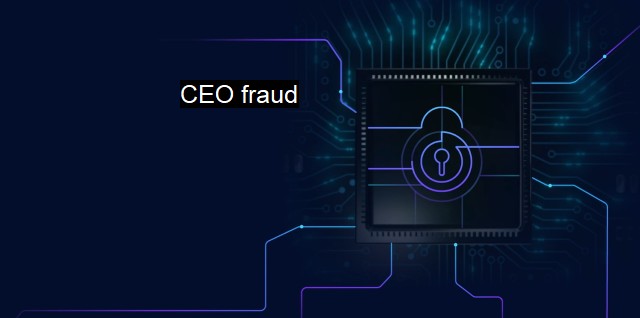What is CEO fraud?
CEO Fraud Unveiled: The Alarming Rise in Business Email Compromise and How Cybercriminals Deceive Companies Out of Millions
CEO fraud, often known as business email compromise (BEC), is a sophisticated scam where cybercriminals trick employees into transferring money or sensitive information by impersonating senior executives or business partners mainly through deceptive email channels. This type of cyber-crime has gained popularity among cybercriminals due to its lucrative nature and can lead to considerable financial losses, as well as damaging company reputation.At the heart of CEO fraud lies cybercriminals' knowledge of social engineering techniques - the manipulation of individuals to illicit action benefitting the perpetrators. The success of these attacks relies heavily on the legitimate-looking emails that skillfully manipulate the victim's trust and authority levels within the organization.
A deeper indulgence into the processes accompanying a CEO fraud reveals a closer resemblance to a well-prepared stage play than a random crime. Cybercriminals often perform extensive research, studying both the organizational hierarchy and the CEO's lifestyle, speech patterns, and decision-making process, before crafting a persuasive deceitful narrative.
Typically, these criminals exploit characteristics of the ordinary business environment where fast response, ease of digital transactions, and global connectivity often override prudent reflection and security considerations. An unsuspecting employee receives a fraudulent email mimicking the CEO's idiosyncrasies and urgently requesting a transfer to an account or divulgence of sensitive information.
Arguably the most potent aspect of CEO fraud is their leverage on humans' inherent trust in representing authority - in this case, the CEO. Although considerable resources have been directed to fortifying firewalls, setting up secure networks, and antivirus programs to patch vulnerable software, protecting against CEO fraud draws more on employees' awareness and the nurturing of a sound security culture.
It's crucial to note that CEO fraud extends beyond purely financial transactions. Sophisticated scams may aim to glean access passwords, trade secrets, or personal employee information, demonstrating the considerable scope and depth of the risks associated with this form of cyber-attack.
In light of the escalating menace posed by CEO fraud elaborately manifested in its ingenuity and escalating financial impacts, efforts to curtail it have necessitated equally elaborate responses. Organizations are investing significantly in cultivating a robust information security culture, structured awareness programs, intelligent machine learning algorithms for identifying peculiar email activities, and implementing robust email security practices.
As an integral aspect of cybersecurity, firewalls and antiviruses are continually being upgraded to encompass traits of BECs. Artificial intelligence (AI) and machine learning are incorporated for their ability to pinpoint potentially harmful deviations in text semantics, grammar, emailing patterns, and many other phishing signs often missed by human scrutiny.
A complementary approach focuses on email authentications tech like Domain-based Message Authentication, Reporting, and Conformance (DMARC), and Sender Policy Framework (SPF) to prevent email spoofing and phishing. Antivirus software providers are introducing more advanced features for 'sandboxing' emails, isolating them from the main network until ensured they're safe.
Many cybersecurity experts argue for a more proactive, rather than reactive, cyber-defense position. Simulated phishing campaigns to expose employees to dignified breaches, empowering them to identify, report, and prevent actual phishing attempts holds prominence. Exertions extend to creating collaborative platforms for sharing threat intelligence across sectors to remain ahead of the crafty cyber adversaries.
The challenge that CEO fraud poses to businesses across the globe is considerable, necessitating a much broader approach than ordinary antivirus mechanisms. Its especial reliance on employee manipulation underscores the importance of evolving beyond purely technological defense mechanisms. Everyone in the organization has a role to play in edging the cybersecurity war against the potential ravages of CEO fraud, invoking a harmonious synergy of technology and human strategy.

CEO fraud FAQs
What is CEO fraud?
CEO fraud is a type of cybercrime in which an attacker impersonates a senior executive or other high-level employee to deceive an employee or vendor into transferring funds or sensitive information.What are the common techniques used in CEO fraud attacks?
The most common techniques used in CEO fraud attacks include spoofed email addresses or domains, social engineering tactics, and phishing scams. Attackers may also use phone calls or text messages to impersonate the CEO or other high-level executives.How can companies protect themselves from CEO fraud attacks?
Companies can protect themselves from CEO fraud attacks by implementing cybersecurity measures such as multi-factor authentication, strong passwords, and employee training on recognizing phishing scams. They should also establish clear policies and procedures for financial transactions and vendor communications, including verification processes for requests initiated by senior executives.What should companies do if they fall victim to a CEO fraud attack?
If a company falls victim to a CEO fraud attack, they should contact law enforcement immediately and report the incident to their bank. They should also perform a thorough investigation to determine how the attack occurred and take steps to prevent future attacks. Companies should also consider hiring a cybersecurity consultant to assist with identifying vulnerabilities and implementing stronger security measures.| | A | | | B | | | C | | | D | | | E | | | F | | | G | | | H | | | I | | | J | | | K | | | L | | | M | |
| | N | | | O | | | P | | | Q | | | R | | | S | | | T | | | U | | | V | | | W | | | X | | | Y | | | Z | |
| | 1 | | | 2 | | | 3 | | | 4 | | | 7 | | | 8 | | |||||||